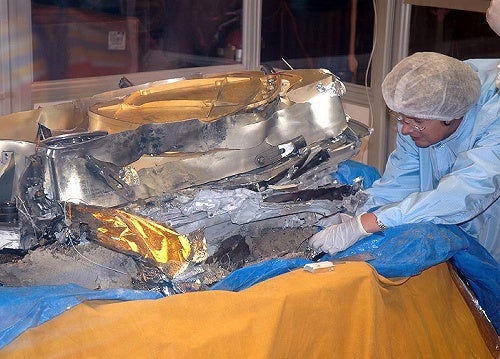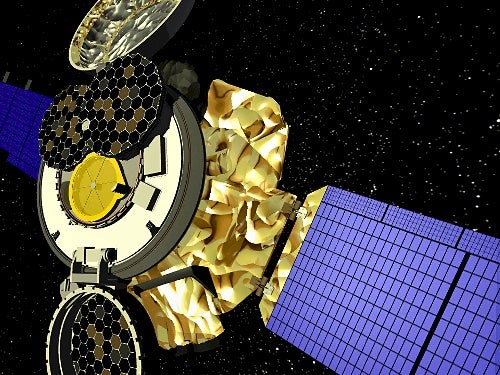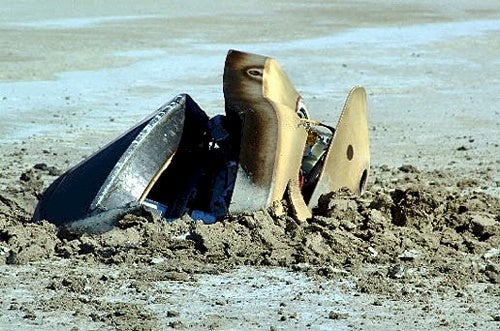On Tuesday, Genesis team scientists recovered half of a sapphire wafer used to collect solar particles — the largest fragment of the Sun-sampling spacecraft’s collector array yet found. As scientists and engineers meticulously examine the canister, hope continues to grow that the crashed spacecraft’s battered contents will provide the data needed to meet some, if not all, of the mission’s science goals.
Right now, the canister lies on its lid in a specially constructed clean room at the U.S. Army Proving Ground in Dugway, Utah, southwest of Salt Lake City. Scientists are methodically working their way through the canister bottom to top, trimming away small portions of the canister’s wall and retrieving pieces of its smashed payload. They continue to find small but potentially analyzable fragments of the collector array.
The solar particles captured by Genesis represent the first extraterrestrial material deliberately brought to Earth since Apollo 17 astronauts delivered lunar rocks in 1972. The samples — billions of ions captured from the solar wind — ultimately will be sent to NASA’s Johnson Space Flight Center in Houston for study, but at this point, there are no plans to ship the probe’s contents.
The mission’s top priority was measurement of oxygen isotopes in the solar wind, a flow of ions that continually streams from the Sun’s surface. Different theories advanced different roles for the element, and it had been hoped the Genesis samples would show which were correct, if any. Four segments of the craft’s solar wind concentrator captured oxygen ions. The condition of these segments will be better known over the next few days, after scientists extract the experiment. They now believe one of the segments may have sustained multiple fractures, but the other three appear more or less intact.
One experiment collected ions from the solar wind on 275 hexagonal wafers. Although some tiles still lie mounted in their holders, the force of the impact broke nearly all of them. “We won’t really know how many . . . for some time, but we are far more hopeful important science can be conducted,” Wiens noted last week.
Metal foils on the lid of the science canister also served as sample collectors. Dave Lindstrom, a mission program scientist at NASA headquarters, reported that about 75 percent of the foils could be recovered. Gold foil is particularly important. Nitrogen ions embedded within it will shed light on the evolution of planetary atmospheres, another of the mission’s scientific goals. However, the unexpected exposure of the foils to the Utah desert will complicate any analysis.
NASA’s much-publicized plans called for a helicopter to snatch the Genesis capsule out of the air as it drifted to Earth on its wing-like main parachute. The helicopter was then to fly the capsule and its contents to Michael Army Air Field, where technicians would remove the canister containing the samples.
Instead, at 9:52:47 a.m. MDT on September 8, the 5-foot-wide (1.5 meter), 420-pound (205 kilogram) sample return capsule (SRC) slammed into the desert floor at a speed of 193 miles (310 kilometers) per hour.
A mortar was supposed to fire as the capsule, still moving at supersonic speed, descended to 100,000 feet (30 km). This mini-explosion would release a drogue parachute to slow and stabilize the vehicle. At 20,000 feet (6.1 km), the drogue would be cut away and pull out the main parafoil, which ultimately would slow the craft to just 9 miles (14 km) per hour.
But as the tumbling capsule clearly became visible to television cameras, mission controllers radioed the recovery helicopter: “It looks like we have a no-chute, sir. . . . Look for an impact.”
“The spacecraft was designed in a way to give us the best chance at salvaging the valuable science payload should we suffer a landing like the one we witnessed today,” said NASA Administrator Sean O’Keefe in a statement the day of the impact. “With each new mission, we push the frontiers of our knowledge and technology, and we’re hopeful that what appears to be a setback will eventually return some impressive results.”
Once the capsule’s impact was confirmed, flight crews landed nearby and began to document the damage. “The SRC penetrated the soil to about half its diameter,” said Roy Haggard, director of helicopter flight operations for the mission, speaking at the September 8 press conference. It was clear the mortar hadn’t fired, he said, which presented a risk for those trying to recover the craft. Also, damage to the battery that was supposed to trigger the mortar could cause it to release dangerous sulfur dioxide fumes.
Haggard said the “canister was slightly breached, maybe just a few inches” from the high-velocity impact, but “it was difficult to tell looking into the canister just how much damage it took.” Considering the speed of the impact, he noted, “it was actually quite surprising how little damage there was.”
But without the ultra-clean precautions originally planned, recovery of any science data from the $264-million mission will be made much more difficult. “Our hearts really go out to the science team, which is going to have a tougher job,” Haggard said.
The science canister, damaged by the impact, was moved by helicopter to a clean room constructed near the crash site. Technicians removed the canister’s foil wrapping, carefully brushed away dirt, and then brought the canister and its contents into the clean room for analysis.
Genesis spent 884 days collecting the particles, trapping them in metal foils, in a multi-segment concentrator, and on 275 4-inch-wide (10 centimeter) hexagonal tiles. These tiles were made from a variety of materials — including silicon, germanium, sapphire, artificially-created diamond, and metallic glass — selected to target ions of specific elements. Scientists expected these experiments to return just 0.4 micrograms of solar material.
Two other sample return missions are currently in progress. NASA’s Stardust, which collected particles from Comet Wild 2 in January, will return its samples in 2006 to the same Utah site Genesis used. A Japanese probe named Hayabusa is scheduled to land on asteroid Itokawa next year and return samples in 2007.












